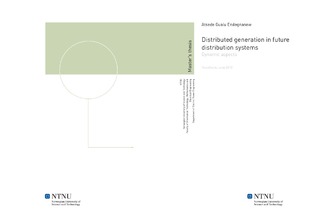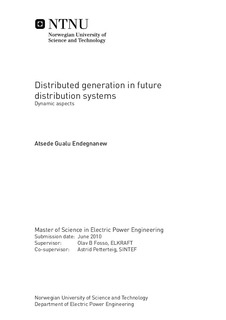| dc.description.abstract | The objective of this thesis work was to study the stability of a distribution network with several distributed generators (DGs) considering different types of regulators in the DGs and loading conditions. The distribution network under study, Øie Kvinesdal, is a 57 km long radial feeder. It contains 8 distributed generators; seven synchronous and one induction generator. The largest generator has 10.3 MW rated power and the lowest has 0.25 MW rated power. The first and last generators are located 7.3 km and 45 km away from the 106/22 kV transformer respectively. Four of the synchronous generators are located on the same side branch.Four cases were studied with three different total active power production levels, two medium and one maximum production levels, and two different network loading conditions, high and low load.In each case, five different types of disturbances were created to analyse the dynamic response of the distribution network. The disturbances are synchronous generator disconnection, change in load, change in system voltage, short circuit fault, and disconnection of the 22 kV feeder from the HV network. Five different scenarios of synchronous generator disconnections were studied; disconnecting the largest four one by one and disconnecting the smallest three at the same time. Two different scenarios of load changes were studied. The first one is a step change in load either from high load to low load or from low load to high load depending on the initial loading condition of the network. The second type of change in load is disconnection of loads in one area which account to 66% of the total loads in the system. Change in system voltage was created by a 2.5 % step up on the swing bus voltage. The pre-disturbance linear analysis result showed that controllers connected to the smallest generators have strong relations with the least damped eigenvalues. The case with maximum generation and low loading had very low damped oscillations; as low as 6% damping ratios. Selecting appropriate regulator gain constants plays vital role in the distribution system s small signal stability. There are some eigenvalues with imaginary part as high as 11 Hz. This is due to the low inertia of the distributed generators.The generators in all cases were able to regain synchronism after disturbances caused by disconnection of synchronous generators, change in load and system voltage. This is because the distribution network is connected to a strong high voltage network. But not all studied scenarios had terminal voltage and power factor within the allowed range in their post-disturbance steady state. Depending on settings of reactive power and over voltage relays, and how quickly a new set point is calculated for the excitation system controllers, a cascade of faults may occur. This could lead to instability. Relays were not included in this study.The critical clearing time for the case with maximum production and low load was the shortest because the distribution network had high voltage and the DGs were operating with their rated capacity in the pre-disturbance steady state. The distribution network was not able to reach new steady state, and be able to operate in island mode after disconnection of the feeder from the HV network with the turbine and governor models used. | nb_NO |

